
| << back | INDEX | next >> |
 |
|
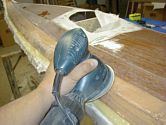 |
When
the weave of the cloth is positively filled (you will not see any cloth
texture), you can do intermittent sanding before applying the last filler
coat (or two). I am using 60 grit orbital sander to knock down the high
spots. The flat facets of the stitch and glue plates makes sanding very
easy and it can be done quite systematically. See more epoxy sanding in the "stripper" section of Kayak Shop |
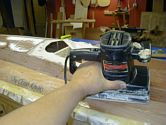 |
Finish sander with 40 grit dry paper is also good. I often use both sanders, one in each hand. |
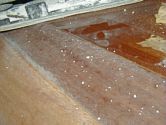 |
When the epoxy has just cured, it is solid but it softens very easily by the friction of the sanding. The softened epoxy which has the consistency of "hard toffee candy" will "clump" into these epoxy balls. This is very nice since the dust clings together and drops to the floor. The sanding will remove the softer epoxy more aggressively than if you waited a few days. The epoxy and the sanding gets harder by the day the longer you wait to sand. |
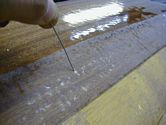 |
Nice close-up of the high spots knocked down to the level of the low spots. The next filler coat will be much smoother and 180 grit wet dry paper for the final sanding is very effective. As soon as you see grit scratches in the low spots, sanding is done. |
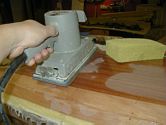 |
The last step is 180 grit wet sanding. This will leave the epoxy ready for coating with varnish. If you need more filler coats after this, add more! |
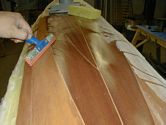 |
The squeegee will clean the wet surface nicely. It will reveal the condition of the surface and you can determine if any more sanding or filler coats have to be done. |
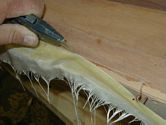 |
Trimming
off the protective skirt which shielded the hull below from water, epoxy
and debris. Do this right after the glassing while the epoxy is still
soft. You can re-mask right afterwards to do the filler coats. This
way you will not have a thick and days old hardened epoxy layer to cut through.
If you are working with slow epoxies and are relatively quick with the filler
coats then the only one masking job is needed. The masking tape under the fiberglass covers at most 0.5" (12mm) of the edge of the plate. It must also cover the wire holes so that epoxy does not get in. |
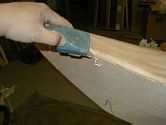 |
Finish
the cut with a sharp scraper. The edge will always be a bit thicker (epoxy
rich) since the epoxy drains to the edges especially when filler coating. See more epoxy sanding in the "stripper" section of Kayak Shop |
| << back | INDEX | next >> |
| Home | Kayak Designs | Kayak Shop | Materials | Kayak Gallery | About us |
| Building Manual | Plans | Sandwich Core | Wood Kayak | Order | |
| Epoxy Test | Abrasion Cloth | Rudder | Resources | Choosing Kayak | Guestbook |
If you notice any problems with the site (i.e. error links, missing images) please, let me know. Thanks
Mail:
Vaclav Stejskal
10 Colonial Court apt. 73
Stoneham, MA. 02180
USA
Tel: 781-481-9261
© 1999
- 2020 Copyright Vaclav Stejskal
All rights reserved
Last page update:
11 January 2020